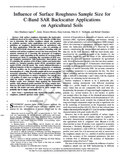Mostrar el registro sencillo del ítem
Influence of surface roughness sample size for C-band SAR backscatter applications on agricultural soils
| dc.creator | Martínez de Aguirre Escobar, Alejandro | es_ES |
| dc.creator | Álvarez-Mozos, Jesús | es_ES |
| dc.creator | Lievens, Hans | es_ES |
| dc.creator | Verhoest, Niko E. C. | es_ES |
| dc.creator | Giménez Díaz, Rafael | es_ES |
| dc.date.accessioned | 2019-02-04T13:51:39Z | |
| dc.date.available | 2019-12-01T00:00:11Z | |
| dc.date.issued | 2017 | |
| dc.identifier.citation | A. Martinez-Agirre, J. Álvarez-Mozos, H. Lievens, N. E. C. Verhoest and R. Giménez, "Influence of Surface Roughness Sample Size for C-Band SAR Backscatter Applications on Agricultural Soils," in IEEE Geoscience and Remote Sensing Letters, vol. 14, no. 12, pp. 2300-2304, Dec. 2017. doi: 10.1109/LGRS.2017.2762434 | en |
| dc.identifier.issn | 1545-598X | |
| dc.identifier.uri | https://hdl.handle.net/2454/32129 | |
| dc.description.abstract | Soil surface roughness determines the backscatter coefficient observed by radar sensors. The objective of this letter was to determine the surface roughness sample size required in synthetic aperture radar applications and to provide some guidelines on roughness characterization in agricultural soils for these applications. With this aim, a data set consisting of ten ENVISAT/ASAR observations acquired coinciding with soil moisture and surface roughness surveys has been processed. The analysis consisted of: 1) assessing the accuracies of roughness parameters s and l depending on the number of 1-m-long profiles measured per field; 2) computing the correlation of field average roughness parameters with backscatter observations; and 3) evaluating the goodness of fit of three widely used backscatter models, i.e., integral equation model (IEM), geometrical optics model (GOM), and Oh model. The results obtained illustrate a different behavior of the two roughness parameters. A minimum of 10-15 profiles can be considered sufficient for an accurate determination of s, while 20 profiles might still be not enough for accurately estimating l. The correlation analysis revealed a clear sensitivity of backscatter to surface roughness. For sample sizes >15 profiles, R values were as high as 0.6 for s and ~0.35 for l, while for smaller sample sizes R values dropped significantly. Similar results were obtained when applying the backscatter models, with enhanced model precision for larger sample sizes. However, IEM and GOM results were poorer than those obtained with the Oh model and more affected by lower sample sizes, probably due to larger uncertainly of l. | en |
| dc.description.sponsorship | This work was supported by the Spanish Ministry of Economy and Competitiveness through scholarship under Grant BES-2012-054521 and through MINECO/FEDER, EU, under Project CGL2011-24336, Project CGL2015-64284-C2-1-R, and Project CGL2016-75217-R. | en |
| dc.format.extent | 12 p. | |
| dc.format.mimetype | application/pdf | en |
| dc.language.iso | eng | en |
| dc.publisher | IEEE | en |
| dc.relation.ispartof | IEEE Geoscience and remote sensing letters, vol. 14, nº 12, december 2017 | en |
| dc.rights | © 2017 IEEE. Personal use of this material is permitted. Permission from IEEE must be obtained for all other uses, in any current or future media, including reprinting/republishing this material for advertising or promotional purposes, creating new collective works, for resale or redistribution to servers or lists, or reuse of any copyrighted component of this work in other works. | en |
| dc.subject | Agricultural soils | en |
| dc.subject | Backscatter models | en |
| dc.subject | Surface roughness | en |
| dc.subject | Synthetic aperture radar (SAR) | en |
| dc.title | Influence of surface roughness sample size for C-band SAR backscatter applications on agricultural soils | en |
| dc.type | Artículo / Artikulua | es |
| dc.type | info:eu-repo/semantics/article | en |
| dc.contributor.department | Proyectos e Ingeniería Rural | es_ES |
| dc.contributor.department | Landa Ingeniaritza eta Proiektuak | eu |
| dc.contributor.department | Institute on Innovation and Sustainable Development in Food Chain - ISFOOD | es_ES |
| dc.rights.accessRights | Acceso abierto / Sarbide irekia | es |
| dc.rights.accessRights | info:eu-repo/semantics/openAccess | en |
| dc.embargo.terms | 2019-12-01 | |
| dc.identifier.doi | 10.1109/LGRS.2017.2762434 | |
| dc.relation.projectID | info:eu-repo/grantAgreement/MICINN//CGL2011-24336/ES/ | en |
| dc.relation.projectID | info:eu-repo/grantAgreement/MINECO//CGL2015-64284-C2-1-R/ES/ | en |
| dc.relation.projectID | info:eu-repo/grantAgreement/ES/1PE/CGL2016-75217 | en |
| dc.relation.publisherversion | https://dx.doi.org/10.1109/LGRS.2017.2762434 | |
| dc.type.version | Versión aceptada / Onetsi den bertsioa | es |
| dc.type.version | info:eu-repo/semantics/acceptedVersion | en |


